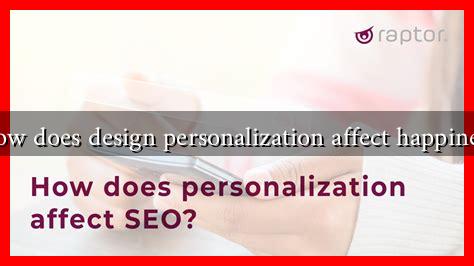-
Table of Contents
How Does Design Personalization Affect Happiness?
In an increasingly digital world, design personalization has emerged as a powerful tool that influences our daily experiences. From tailored advertisements to customized user interfaces, the ability to personalize design has profound implications for our happiness and overall well-being. This article explores how design personalization affects happiness, supported by research, examples, and case studies.
The Psychology of Personalization
At its core, design personalization taps into fundamental psychological principles. When individuals encounter designs that resonate with their preferences, they experience a sense of ownership and connection. This phenomenon can be explained through several psychological theories:
- Self-Determination Theory: This theory posits that people are happier when they feel autonomous and in control of their choices. Personalized designs cater to individual preferences, enhancing feelings of autonomy.
- Maslow’s Hierarchy of Needs: Personalization can fulfill higher-level psychological needs, such as esteem and self-actualization, by allowing individuals to express their identities through design.
- Flow Theory: Personalized experiences can lead to a state of flow, where individuals are fully immersed and engaged, contributing to greater happiness.
Real-World Examples of Design Personalization
Numerous companies have successfully implemented design personalization strategies that have positively impacted user happiness. Here are a few notable examples:
- Spotify: The music streaming service uses algorithms to create personalized playlists, such as “Discover Weekly.” Users report higher satisfaction levels when they receive music recommendations tailored to their tastes, enhancing their overall enjoyment of the platform.
- Netflix: By personalizing content recommendations based on viewing history, Netflix increases user engagement and satisfaction. A study found that personalized recommendations can lead to a 70% increase in user retention.
- Amazon: The e-commerce giant employs personalization techniques to suggest products based on previous purchases and browsing behavior. This not only improves the shopping experience but also fosters a sense of connection between the consumer and the brand.
The Impact of Personalization on Mental Health
Design personalization can also have significant implications for mental health. A study published in the journal Computers in Human Behavior found that personalized digital environments can reduce feelings of anxiety and depression. Here are some ways personalization contributes to mental well-being:
- Reduced Cognitive Load: Personalized designs simplify decision-making processes, reducing stress and cognitive overload.
- Enhanced Social Connection: Customizable social media profiles allow users to express their identities, fostering a sense of belonging and community.
- Increased Motivation: Personalized goal-setting applications can help individuals stay motivated and achieve their objectives, leading to a sense of accomplishment and happiness.
Challenges and Considerations
While design personalization has many benefits, it is essential to consider potential challenges:
- Privacy Concerns: Users may feel uncomfortable with the amount of data collected for personalization, leading to distrust.
- Over-Personalization: Excessive personalization can create echo chambers, limiting exposure to diverse perspectives and experiences.
- Accessibility Issues: Not all users may have the same level of access to personalized experiences, potentially leading to feelings of exclusion.
Conclusion
Design personalization plays a crucial role in enhancing happiness by fostering a sense of autonomy, connection, and engagement. As demonstrated through various case studies and psychological theories, personalized experiences can lead to greater satisfaction and improved mental health. However, it is essential to navigate the challenges associated with personalization carefully. By striking a balance between personalization and privacy, we can harness the power of design to create happier, more fulfilling experiences for all.
In summary, the impact of design personalization on happiness is profound and multifaceted. As we continue to embrace personalized experiences in our digital lives, understanding its implications will be key to enhancing our overall well-being.


